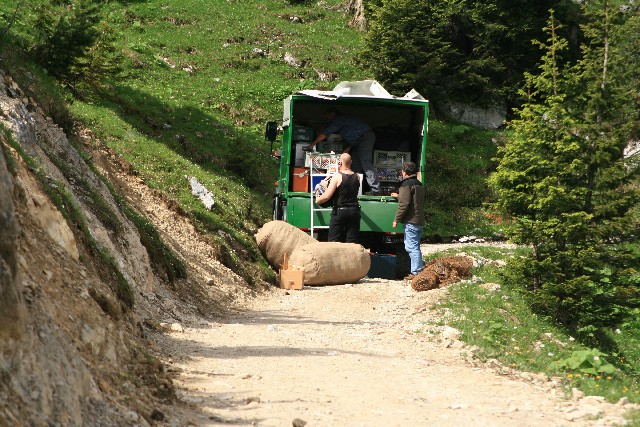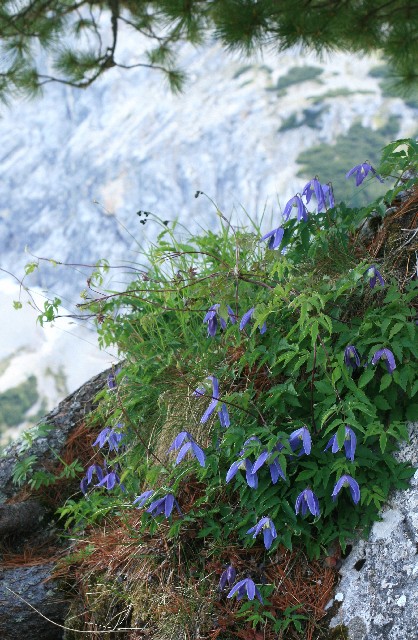Schachen Log 3
It’s time to pack my trunks for 6 weeks on the Schachen with the usual mix of clothing for summer, winter and everything in between, as well as reading material for rainy days and evenings. My e-book, an excellent invention for long trips, leaves more space for reference books. Weight and amount of luggage is voluntarily kept to a minimum as everything we need from food to clothing, garden guides to postcards and firewood has to be carried or wheeled from the Unimog at the garden entrance to the hut on the other side of the garden along a fairly narrow path and down some steep steps. The soil and young plants can thankfully be unloaded directly from the Unimog into the ‘nursery area’. The term ‘nursery’ is used loosely here for the area around our water tank (12 m3) which is fenced off to keep the cows off the reservoir roof. On one side are the compost heaps – one for green compost and the other heap mainly soil dug out when replanting. Along the front of the reservoir are compartments to hold the sterilised soil, sand and grit, both acidic and neutral. The other side of the area contains the Adenostyles collection for DNA studies of plants grown from seed collected from numerous geographically separate colonies. A small strip of soil at the entrance is used to plunge new plants before planting.
Our transport up to the Schachen.

It’s a Megacarpaea year again with Megacarpaea polyandra coming into flower. The last plant flowered on the Schachen in 2004 - http://www.botmuc.de/en/garden/schachen_megacarpaea_polyandra.html .
Last Tuesday (7th June) the flower spike was already over a metre tall and the first flowers were open. From seedling to flowering it takes approximately 10 years. Years ago I read somewhere that these plants are commonly grown in southern England for their attractive leaf rosette. That must have been in the cooler, moister past. In Munich the plants grow extremely slowly and unhappily and it’s doubtful whether they’ll ever flower because as soon as it gets hot the rosette goes dormant. On the Schachen, on the other hand, with the cool temperatures and abundant moisture, Megacarpaea grows very well but doesn’t always set seed if the summer is cold for too long with snow.
A member of the Brassicaceae, the young shoots and leaves are edible and would be in danger of joining our list of useful plants in the kitchen if they didn’t take so long to flower. Ligusticum mutellinum is one of the indigenous alpines which we use almost daily in salads as the leaves are an excellent substitute for parsley. The only vegetables which we can grow with any success on the Schachen are radishes, although they take twice as long reach the size of a walnut as those grown in the valley, and Cos lettuces. But one disastrous year where it snowed soon after planting the lettuces; which they survived; followed by hail just before harvesting; which they also survived; and then a cow got into the compost area and took one saliva filled bite out of each lettuce - 12 in all! We composted the remains and I’ve never tried lettuces again.
Other plants in flower at the moment:
Ranunculus parnassifolius which grow in moist, fine limestone scree. They set seed readily and I let them sow themselves around the mother plants as the seed does not store well and is not collected for distribution to other gardens.
Primula ioessa which grows in very wet meadows of Tibet and Nepal. It always flowers early on the Schachen and seldom sets seed. Perhaps there are not enough pollinators present at the time when it flowers?
Primula parryi from North America which according to John Richards book 'Primula' grows in moist to wet habitats '…running snow-melt, stream-banks, …. seepage lines…'
You can see a theme developing for plants which grow on the Schachen, they all need lots of water while in growth. A typical Schachen summer is a few days of sun followed by a thunder storm and a few days of mist and cool weather. Unfortunately the pattern seems to be changing to many (7 - 10) days of sun followed by a cloud burst and very few misty days. Last August broke the pattern with 4 weeks of rain and mist.
Androsace mucronifolia
Cotula pyrethrifolia
Daphne glomerata grown from seed collected in the Caucasus.
Clematis alpina growing at the foot of Pinus cembra outside of the garden.

The internet connection on the Schachen is unreliable at best so I'll post my next blog in 2 weeks time on my first free weekend in Munich.
In the meantime if you're curious as to the weather conditions on the Schachen click on the following link - http://www.botmuc.de/en/garden/schachen_climate.html